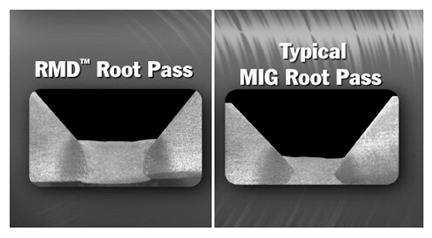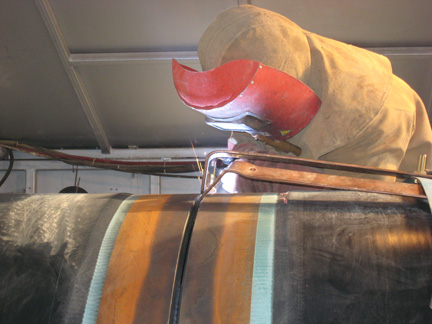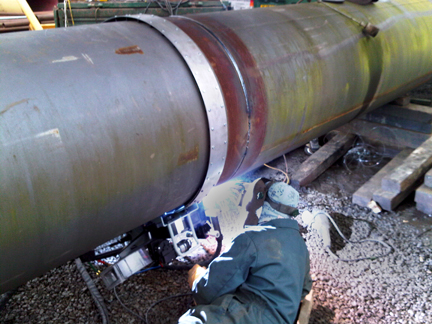Combining Advanced Technologies Can Improve Pipeline Welding Performance
With the demand for energy growing worldwide, contracting companies responsible for constructing transmission pipelines are beginning to face some real obstacles-not the least of which is meeting increasingly tighter project deadlines. To help, welding equipment and filler metal manufacturing companies have begun developing advanced technologies that can significantly increase productivity, lower costs and ease training among welding operators with varied skill sets. These technologies can also help significantly with the performance of mechanized welding applications. Combining technologies such as Regulated Metal DepositTM (RMD) and Pro-PulseTM welding processes (both developed by Miller Electric Mfg. Co.) with high-strength metal-cored welding wire has thus far proven successful on pipeline projects across the Middle East and China.
So what are these technologies, and how do they yield positive results for the challenges pipeline contractors face?
Understanding the Technologies
Regulated Metal Deposit, or RMD, is a modified short circuit transfer process that can be used for the root passes on both mechanized and semi-automatic pipe welding applications. Unlike a standard short circuit process in which the short circuits occur at varying intensities and intervals, the RMD process precisely controls the welding current during all phases of metal transfer, resulting in a highly stable arc and minimal weld puddle agitation.
Like RMD, the Pro-Pulse process is also a sophisticated technology that precisely controls the arc and weld puddle. It is especially useful for out-of-position fill and cap pass welds on pipe. This advanced pulsed MIG process achieves these results by controlling both current and voltage to keep them within the optimum range for a specific wire type and diameter, wire feed speed, and gas combination. Both RMD and Pro-Pulse are software-driven processes that can be found together in inverter-based welding systems (Miller’s PipePro). Because companies can operate the two separate processes using the same equipment, the technologies can save time and money for purchasing and maintenance. On transmission pipeline projects, pipeline contractors can combine the RMD process with metal-cored wire for the root pass on mechanized applications and use Pro-Pulse technology for the fill and cap passes. The RMD process can also be used with metal-cored wire for semi-automatic welding root passes. (Note, the fill and cap passes on semi-automated applications are typically completed using a flux cored wire).
Combining metal-cored wire with the sophistication of the two welding processes has distinct benefits. First, metal-cored wire, which consists of a hollow metal sheath filled with metallic powders, alloys and arc stabilizers, carries the welding current through the outside metal sheath to produce a broad, cone-shaped arc and a wider penetration profile compared to solid welding wire. This helps ensure good gap bridging and high deposition rates. When the RMD and Pro-Pulse processes are combined with metal-cored wire, the result is a very stable arc and weld puddle with very little to no spatter.
But even more importantly, metal-cored wire can be alloyed to meet the low hydrogen, high-strength requirements of many of the materials used for open transmission pipelines, including X70, X80 and even higher strength steels. In fact, it was the emergence of X80 steel pipe that led to the first successful use of metal-cored wire with RMD and Pro-Pulse in China and the Middle East.

RMD process as compared to a typical MIG Root Pass. Because
of this, welding operators can often speed productivity by skipping
the hot pass.
Greater Consistency Equals Better Quality
Metal-cored wire, RMD and Pro-Pulse technologies yield some very practical benefits for pipeline contractors who operate semi-automatic and/or mechanized welding operations. For those who struggle to train welding operators of varied skill sets on semi-automatic welding applications, the RMD process paired with metal-cored wire can facilitate and expedite the training process. In particular, the RMD process maintains a consistent arc length regardless of electrode stick-out to compensate for welding operators who may have trouble holding a constant stick-out. It also enables a better view of the weld puddle, which increases the welding operators’ control of the process. Such benefits are noteworthy, especially for welding operators who may not have as strong of skill set and tend to increase their wire stick-out when welding from the 4- to 6-O’clock position. (Note that with other welding technologies, a long stick-out can often alter welding parameters and lead to quality issues).
On root passes for both semi-automatic and mechanized welding applications, the calm weld puddle created by the RMD process helps eliminates cold lap, which occurs when molten metal splashes against the sidewall of the pipe and “freezes” without fusion. It is also highly tolerant of high-low misalignment typical in pipeline applications because it has a faster freezing puddle that stays in position and it can bridge gaps of up to 3/16 inch (5mm). This feature combines well with metal-cored wire, as this type of filler metal creates a wide cone-shape arc that also improves gap bridging.
The RMD process also offers consistent root reinforcement on the inside of the pipe, which is important when making welds on open root pipe joints. The RMD process also produces a thicker root pass than conventional MIG Short Circuit. Metal-cored wire adds to these benefits by providing higher deposition rates and a consistent penetration profile. All of these characteristics of RMD with metal-cored wire are especially important to maintaining high quality welds, especially given that many of the new pipeline designs for higher strength materials have moved toward more narrow and complex joint designs that require precise placement of the weld metal.
Metal-cored wires that have proven successful on pipeline projects, particularly those comprised of X80 steel, also provide the ductility to resist hydrogen-induced cracking in the resulting welds, and they can compensate for the extreme temperatures to which these pipelines are subject-often temperatures as low as -40 degrees Celcius/Fahrenheit.
Together, the RMD, Pro-Pulse and metal-cored wire technologies can help pipeline contractors ensure quality root, fill and cap passes and avoid unnecessary rework that could lead to downtime, added costs and potentially missed deadlines. They also increase productivity.
With Speed Comes Productivity
More than any other obstacle that pipeline contractors face, overcoming delays in the welding process for cleaning and/or rework and completing the job as soon as possible is key. To help, the RMD process creates a root pass weld with approximately a 1/8- to 3/16-inch (3 to 5 mm) throat. In many instances, the amount of root pass metal deposited will be sufficient to support the heat input requirements of the first FCAW fill pass on semi-automatic welding applications, allowing welding operators to skip the hot pass.

for semi- automatic welding root passes. (Note, the fill and
cap passes on semi-automated applications are typically
completed using a flux-cored wire).
Using metal-cored wire in combination with RMD for the root passes on semi-automatic and mechanized applications adds to that productivity. Specifically, the wire’s construction allows for greater travel speeds and higher deposition rates-factors that increase productivity by allowing welding operators to weld more efficiently and place more weld metal in a single pass.
On mechanized pipeline welding applications, transitioning to the Pro-Pulse process for the fill and cap passes can eliminate many of the problems associated with standard MIG welding (spatter, etc), often used by contractors and can also enhance productivity. Specifically, due to the process’ precise control of current and voltage, Pro-Pulse creates a steady arc and weld puddle, and it eliminates cold lap and inclusions that can lead to downtime for rework. Coupled with metal-cored wire, which creates low spatter levels, there is minimal inter-pass or post-weld cleaning needed since this type of filler metal does not produce slag. In short, the combined technologies help pipeline contractors spend less time cleaning, less time waiting to weld and more time welding.
To date, pipeline contractors on projects in China and the Middle East have relied specifically on E80C-Ni1 metal-cored wire for the root, fill and cap passes using RMD and Pro-Pulse. This type of wire provides the high tensile strengths and low hydrogen levels required to weld higher-grade pipe material. It typically requires a shielding gas combination of 80 percent Argon and 20 percent CO2. Such capabilities ensure the best quality for the extreme environments of many transmission pipelines by providing reliable impact strengths at low temperatures and resisting cracking.
Final Considerations
Like any welding technology, combining the RMD and Pro-Pulse technologies with metal-cored wires is not a ‘cure-all’ for all the challenges that pipeline contractors will face as pipeline materials and designs continue to change and demands for faster construction continue. However, they are a promising start to overcoming the challenges of training and quality that face most of these companies. And, on the right application, they may just provide the productivity enhancements needed to gain a competitive edge as the need for new sources of energy-and pipelines-continue to increase.
This article was originally published in the January 2010 issue of World Pipelines (copyright Palladian Publications).



